Using Multi-Source Data to Assess the Hydrologic Alteration and Extremes under a Changing Environment in the Yalong River Basin
Abstract
:1. Introduction
2. Study Basin and Data
2.1. Geography and Climate
2.2. Multi-Source Hydrometeorological Data
2.2.1. Precipitation Data
2.2.2. Runoff Data
2.2.3. Evaporation Data
2.2.4. Terrestrial Water Storage Data
2.2.5. Climate Projections Data
3. Hydrological Alteration in the Mainstream Flow
3.1. Hydropower Dam Development
3.2. Hydrological Alteration Assessment Based on IHA-RVA Method
- (1)
- The natural range of streamflow during period of 1959–1997 is calculated using the 33 parameters of the IHA method.
- (2)
- The RVA targets for each 33 IHA parameters are set. Since these hydropower dams in the middle and lower Yalong River reach were mostly built in the past 20 years, the data series is short after construction. If an indicator falls outside the RVA targets, it may have a great impact on the resulting analysis of variability. Therefore, 75% and 25% of the probability of occurrence before changing each indicator are selected as the RVA targets.
- (3)
- The RVA values of 33 IHA parameters are calculated according to the streamflow during the periods of 1998–2011 and 2012–2020, respectively.
- (4)
- Based on the frequency difference of the RVA target and the calculated values, i.e., steps (2) and (3), the measure of hydrologic alteration (Di) is defined as the frequency difference of the i-th index by:
3.3. Comparison of Monthly Mean Flow
3.4. Comparison of Extreme Values
4. Hydrometeorological Extremes under Climate Change
4.1. Variation Characteristics of Water Cycle Factors
4.2. Validation and Partition of Terrestrial Water Storage
4.3. Hydrological Response under Climate Change
4.4. Uncertainty and Outlook
5. Conclusions
- (1)
- The flow regime at Yalong River outlet station changed severely in 2012–2020 after the construction of upstream the Ertan and Jinping-I hydropower dams. It is expected that a more significant impact on the hydrological regime will become evident when Lainghehou reservoir starts to impound water in 2022.
- (2)
- Precipitation is the dominant factor of the water cycle in the basin on a monthly scale, which can explain the temporal variability of runoff, evaporation, and TWSA, but the response of evaporation is gentler than that of runoff. In addition, TWSA is also jointly controlled by runoff and evaporation.
- (3)
- The results of GRACE products and the water resources bulletin have a good comparison on the annual scale. The terrestrial water storage in the basin is mainly regulated by surface water, and the contribution of groundwater is relatively small.
- (4)
- The warming process of the basin in the future is obvious, and the precipitation will increase (~10%), leading to the enhancement of evaporation and runoff processes and the loss of land water storage. The magnitude will increase with the strengthening of the discharge scenario.
Author Contributions
Funding
Data Availability Statement
Acknowledgments
Conflicts of Interest
References
- Rodell, M.; Famiglietti, J.S.; Wiese, D.N.; Reager, J.T.; Beaudoing, H.K.; Landerer, F.W.; Lo, M.-H. Emerging trends in global freshwater availability. Nature 2018, 557, 651–659. [Google Scholar] [CrossRef]
- Piao, S.L.; Ciais, P.; Huang, Y.; Shen, Z.H.; Peng, S.S.; Li, J.S.; Zhou, L.P.; Liu, H.Y.; Ma, Y.C.; Ding, Y.H.; et al. The impacts of climate change on water resources and agriculture in China. Nature 2010, 467, 43–51. [Google Scholar] [CrossRef]
- Galletti, A.; Avesani, D.; Bellin, A.; Majone, B. Detailed simulation of storage hydropower systems in large Alpine watersheds. J. Hydrol. 2021, 603, 127125. [Google Scholar] [CrossRef]
- Zorzetto, E.; Marani, M. Downscaling of rainfall extremes from satellite observations. Water Resour. Res. 2019, 55, 156–174. [Google Scholar] [CrossRef] [Green Version]
- Rodell, M.; Beaudoing, H.K.; L’Ecuyer, T.S.; Olson, W.S.; Famiglietti, J.S.; Houser, P.R.; Adler, R.; Bosilovich, M.G.; Clayson, C.A.; Chambers, D.; et al. The observed state of the water cycle in the early twenty-first century. J. Clim. 2015, 28, 8289–8318. [Google Scholar] [CrossRef] [Green Version]
- Richter, B.D.; Baumgartner, J.V.; Powell, J.; Braun, D.P. A method for assessing hydrologic alteration within ecosystems. Conserv. Biol. 1996, 10, 1163–1174. [Google Scholar] [CrossRef] [Green Version]
- Richter, B.D.; Baumgartner, J.; Wigington, R.; Braun, D. How much water does a river need? Freshw. Biol. 1997, 37, 231–249. [Google Scholar] [CrossRef] [Green Version]
- Olden, J.D.; Poff, N.L. Redundancy and the choice of hydrologic indices for characterizing streamflow regimes. River Res. Appl. 2003, 19, 101–121. [Google Scholar] [CrossRef]
- Chen, Y.D.; Yang, T.; Xu, C.-Y.; Zhang, Q.; Chen, X.; Hao, Z. Hydrological alteration along the middle and upper East River (Dongjiang) basin, South China: A visually enhanced mining on the results of RVA method. Stoch. Environ. Res. Risk Assess. 2010, 24, 9–18. [Google Scholar] [CrossRef]
- Zhang, Q.; Xiao, M.; Liu, C.L.; Singh, V.P. Reservoir-induced hydrological alterations and environmental flow variation in the East River, the Pearl River basin, China. Stoch. Environ. Res. Risk Assess. 2014, 28, 2119–2131. [Google Scholar] [CrossRef]
- Duan, W.; Guo, S.; Wang, J.; Liu, D. Impact of cascaded reservoirs group on flow regime in the middle and lower reaches of the Yangtze River. Water 2016, 8, 218. [Google Scholar] [CrossRef] [Green Version]
- Li, D.; Long, D.; Zhao, J.; Lu, H.; Hong, Y. Observed changes in flow regimes in the Mekong River basin. J. Hydrol. 2017, 551, 217–232. [Google Scholar] [CrossRef]
- Scanlon, B.R.; Zhang, Z.; Save, H.; Sun, A.Y.; Schmied, H.M.; van Beek, L.P.H.; Wiese, D.N.; Wada, Y.; Long, D.; Reedy, R.C.; et al. Global models underestimate large decadal declining and rising water storage trends relative to GRACE satellite data. Proc. Natl. Acad. Sci. USA 2018, 115, E1080–E1089. [Google Scholar] [CrossRef] [Green Version]
- Zhao, C.; Zhang, C.; Yang, S.; Liu, C.; Xiang, H.; Sun, Y.; Yang, Z.; Zhang, Y.; Yu, X.; Shao, N.; et al. Calculating e-flow using UAV and ground monitoring. J. Hydrol. 2017, 552, 351–365. [Google Scholar] [CrossRef]
- Skofronick-Jackson, G.; Petersen, W.A.; Berg, W.; Kidd, C.; Stocker, E.F.; Kirschbaum, D.B.; Kakar, R.; Braun, S.A.; Huffman, G.J.; Iguchi, T.; et al. The global precipitation measurement (GPM) mission for science and society. Bull. Am. Meteorol. Soc. 2017, 98, 1679–1695. [Google Scholar] [CrossRef] [PubMed]
- Miralles, D.G.; Holmes, T.R.H.; De Jeu, R.A.M.; Gash, J.H.; Meesters, A.G.C.A.; Dolman, A.J. Global land-surface evaporation estimated from satellite-based observations. Hydrol. Earth Syst. Sci. 2010, 7, 8479–8519. [Google Scholar] [CrossRef] [Green Version]
- Tapley, B.D.; Bettadpur, S.; Ries, J.C.; Thompson, P.F.; Watkins, M.M. GRACE measurements of mass variability in the earth system. Science 2004, 305, 503–505. [Google Scholar] [CrossRef] [Green Version]
- Warszawski, L.; Frieler, K.; Huber, V.; Piontek, F.; Serdeczny, O.; Schewe, J. The inter-sectoral impact model inter-comparison project (ISI-MIP): Project framework. Proc. Natl. Acad. Sci. USA 2014, 111, 3228–3232. [Google Scholar] [CrossRef] [Green Version]
- Burek, P.; Satoh, Y.; Kahil, T.; Tang, T.; Greve, P.; Smilovic, M.; Guillaumot, L.; Zhao, F.; Wada, Y. Development of the community water model (CWatM v1.04)–A high-resolution hydrological model for global and regional assessment of integrated water resources management. Geosci. Model Dev. 2020, 13, 3267–3298. [Google Scholar] [CrossRef]
- Huang, Q.; Ruimin, W.; Junyan, X.; Qin, G. Spatial and temporal applicability of three precipitation products in the Yalong River basin. J. China Hydrol. 2021, 601, 14–21. (In Chinese) [Google Scholar]
- Majone, B.; Avesani, D.; Zulian, P.; Fiori, A.; Bellin, A. Analysis of high streamflow extremes in climate change studies: How do we calibrate hydrological models? Hydrol. Earth Syst. Sci. 2021, 26, 3863–3883. [Google Scholar] [CrossRef]
- Eyring, V.; Bony, S.; Meehl, G.A.; Senior, C.A.; Stevens, B.; Stouffer, R.J.; Taylor, K.E. Overview of the coupled model inter-comparison project phase 6 (CMIP6) experimental design and organization. Geosci. Model Dev. 2016, 9, 1937–1958. [Google Scholar] [CrossRef] [Green Version]
- Mohamed, A.; Faye, C.; Othman, A.; Abdelrady, A. Hydro-geophysical evaluation of the regional variability of Senegal’s terrestrial water storage using time-variable gravity data. Remote Sens. 2022, 14, 4059. [Google Scholar] [CrossRef]
- Othman, A.; Abdelrady, A.; Mohamed, A. Monitoring mass variations in Iraq using time-variable gravity data. Remote Sens. 2022, 14, 3346. [Google Scholar] [CrossRef]
- Alshehri, F.; Mohamed, A. Analysis of groundwater storage fluctuations using GRACE and remote sensing data in Wadi As-Sirhan, Northern Saudi Arabia. Water 2023, 15, 282. [Google Scholar] [CrossRef]
- Becker, M.; Papa, F.; Frappart, F.; Alsdorf, D.; Calmant, S.; Santos da Silva, J.; Seyler, F. Satellite-based estimates of surface water dynamics in the Congo River basin. Int. J. Appl. Earth Obs. Geoinf. 2018, 66, 196–209. [Google Scholar] [CrossRef] [Green Version]
- Chen, C.; Yan, B.; Guo, J.; Jiang, H.; Li, Z. A framework for projecting future streamflow of the Yalong River basin to climate change. Stoch. Environ. Res. Risk Assess. 2021, 35, 1549–1562. [Google Scholar]
- Ye, A.; Deng, X.; Ma, F.; Duan, Q.; Zhou, Z.; Du, C. Integrating weather and climate predictions for seamless hydrologic ensemble forecasting: A case study in the Yalong River basin. J. Hydrol. 2017, 547, 196–207. [Google Scholar] [CrossRef]
- Liang, Y.; Cai, Y.; Sun, L.; Wang, X.; Li, C.; Liu, Q. Sensitivity and uncertainty analysis for streamflow prediction based on multiple optimization algorithms in Yalong River basin of southwestern China. J. Hydrol. 2021, 601, 126598. [Google Scholar] [CrossRef]
- Guirado, E.M.; Delgado-Baquerizo, M.; Martinez-Valderrama, J.; Tabik, S.; Alcaraz-Segura, D.; Maestre, F.T. Climate legacies drive the distribution and future restoration potential of dryland forests. Nat. Plants 2022, 8, 879–886. [Google Scholar] [CrossRef]
- Martens, B.; Miralles, D.G.; Lievens, H.; van der Schalie, R.; de Jeu, R.A.M.; Fernández-Prieto, D.; Beck, H.E.; Dorigo, W.A.; Verhoest, N.E.C. GLEAM v3: Satellite-based land evaporation and root-zone soil moisture. Geosci. Model Dev. 2017, 10, 1903–1925. [Google Scholar] [CrossRef] [Green Version]
- Kumari, N.; Srivastava, A.; Sahoo, B.; Raghuwanshi, N.S.; Bretreger, D. Identification of suitable hydrological models for streamflow assessment in the Kangsabati River basin, India, by using different model selection scores. Nat. Resour. Res. 2021, 30, 4187–4205. [Google Scholar] [CrossRef]
- Darbandsari, P.; Coulibaly, P. Inter-comparison of lumped hydrological models in data-scarce watersheds using different precipitation forcing data sets: Case study of Northern Ontario, Canada. J. Hydrol.-Reg. Stud. 2020, 31, 100730. [Google Scholar] [CrossRef]
- Shiau, J.T.; Wu, F.C. Pareto-optimal solutions for environmental flow schemes incorporating the intra-annual and inter-annual variability of the natural flow regime. Water Resour. Res. 2007, 43, W06433. [Google Scholar] [CrossRef]
- Mohamed, A.; Abdelrady, A.; Alarifi, S.S.; Othman, A. Geophysical and remote sensing assessment of Chad’s groundwater resources. Remote Sens. 2023, 15, 560. [Google Scholar] [CrossRef]
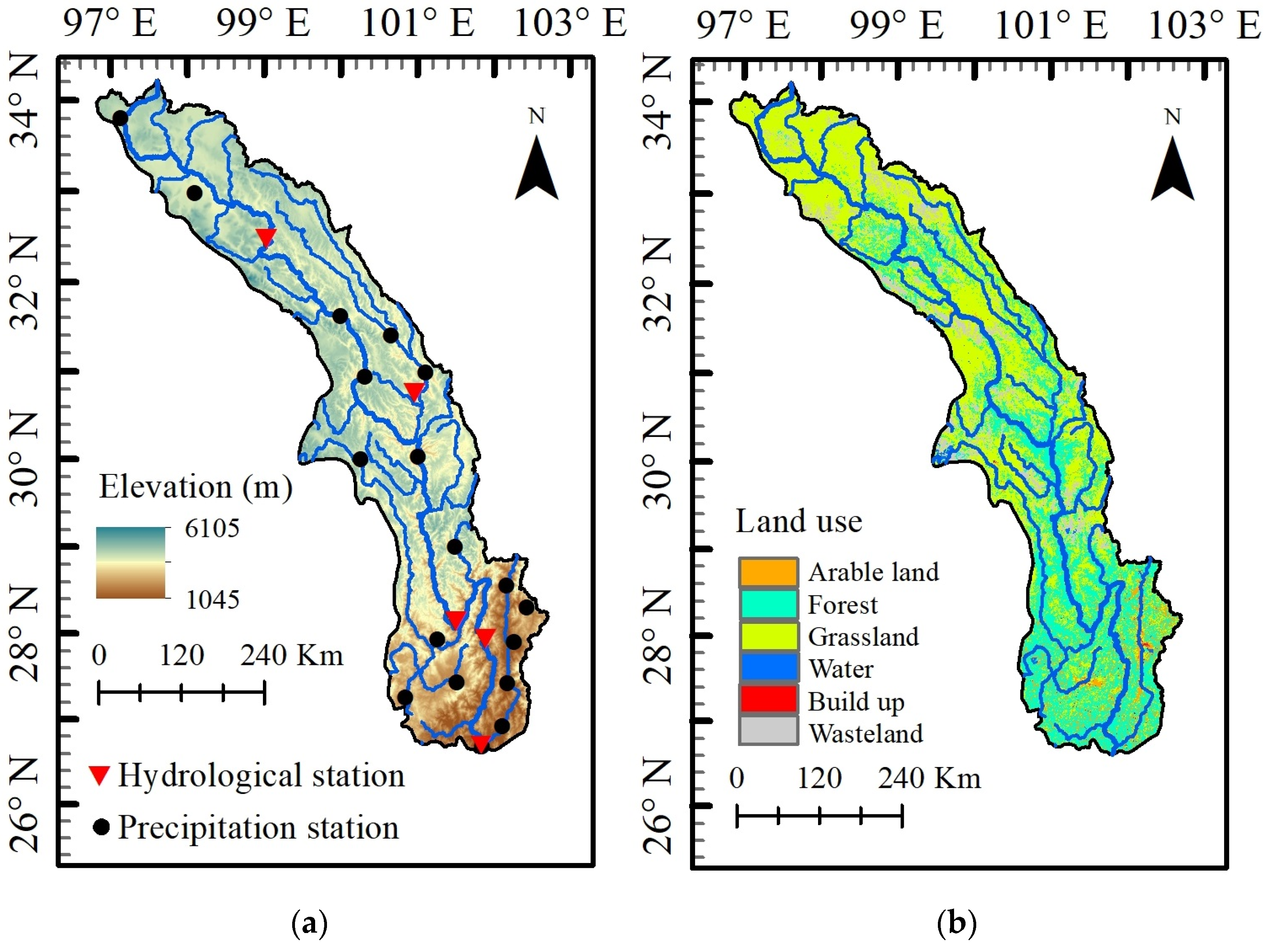



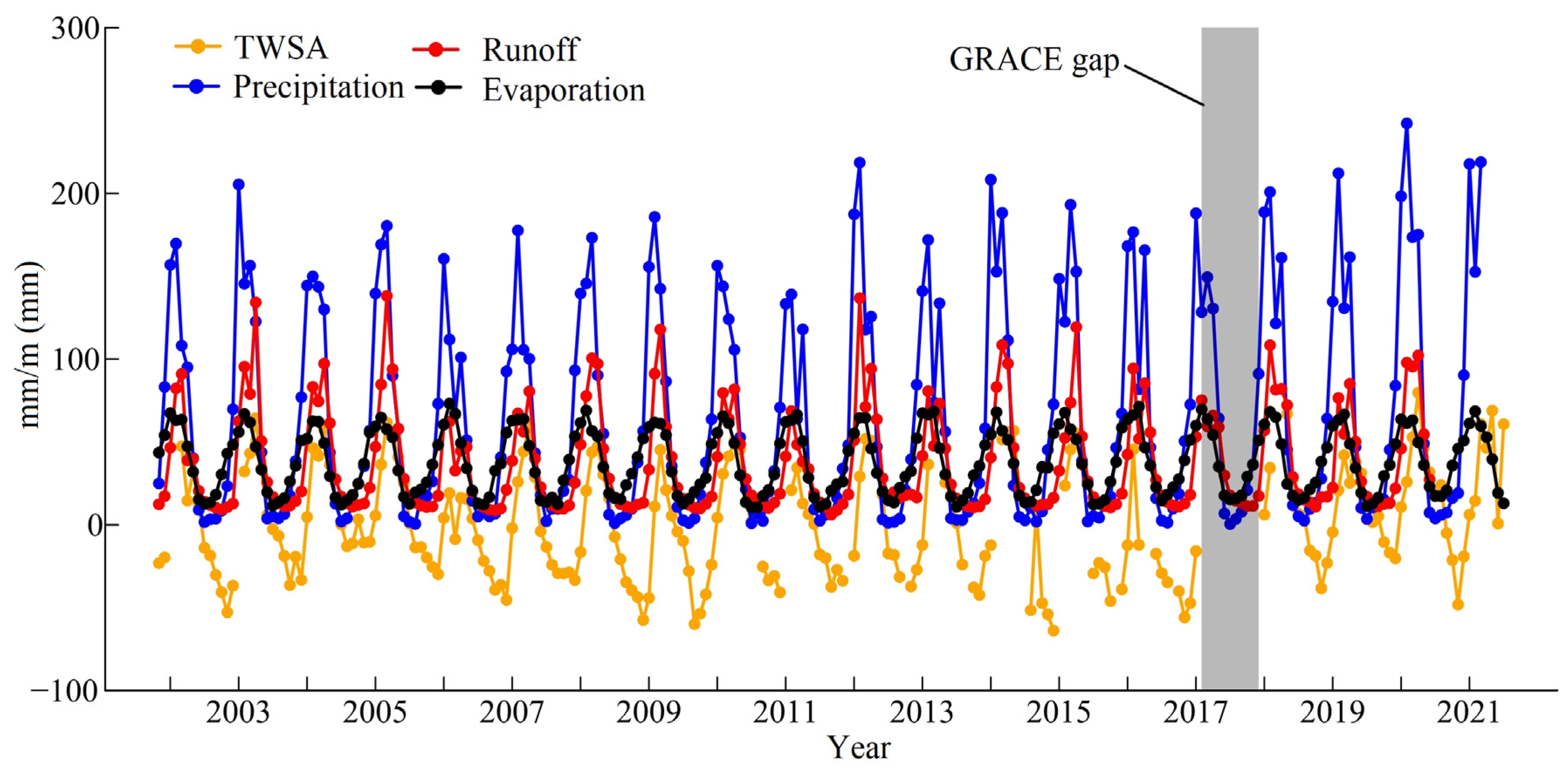

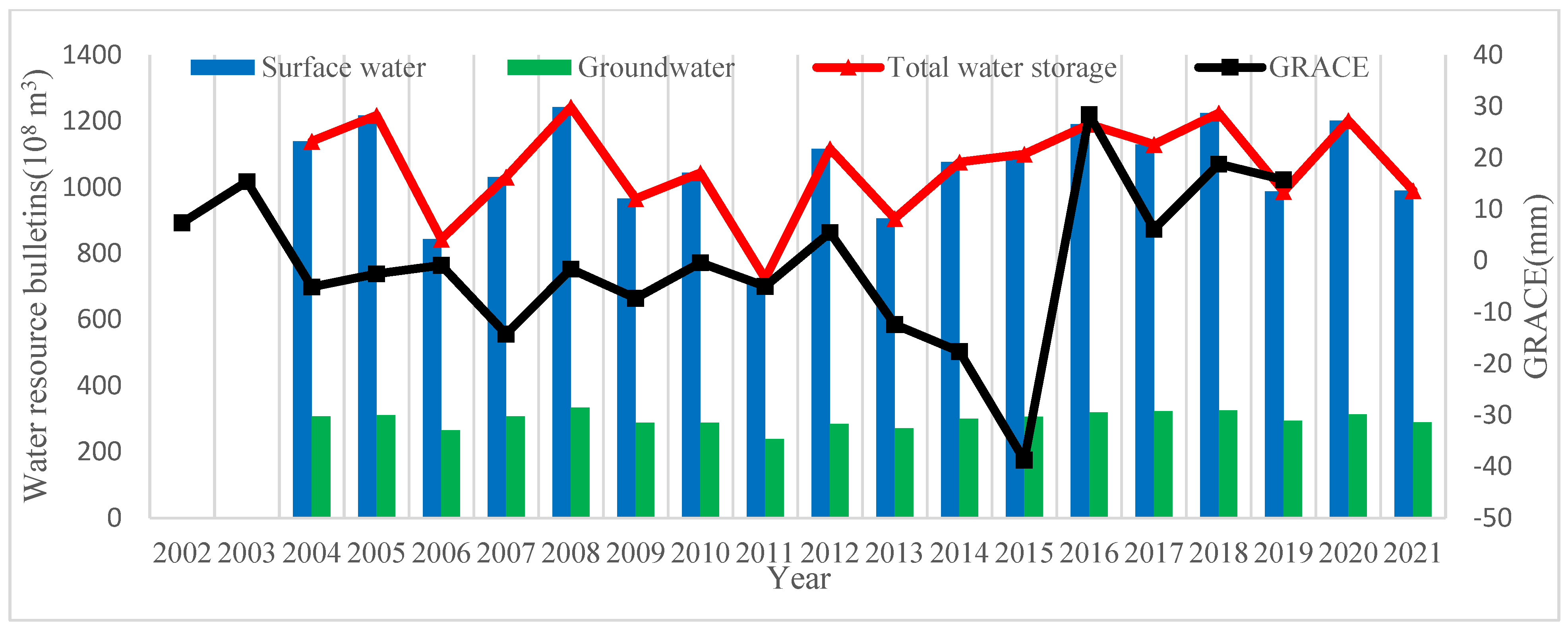

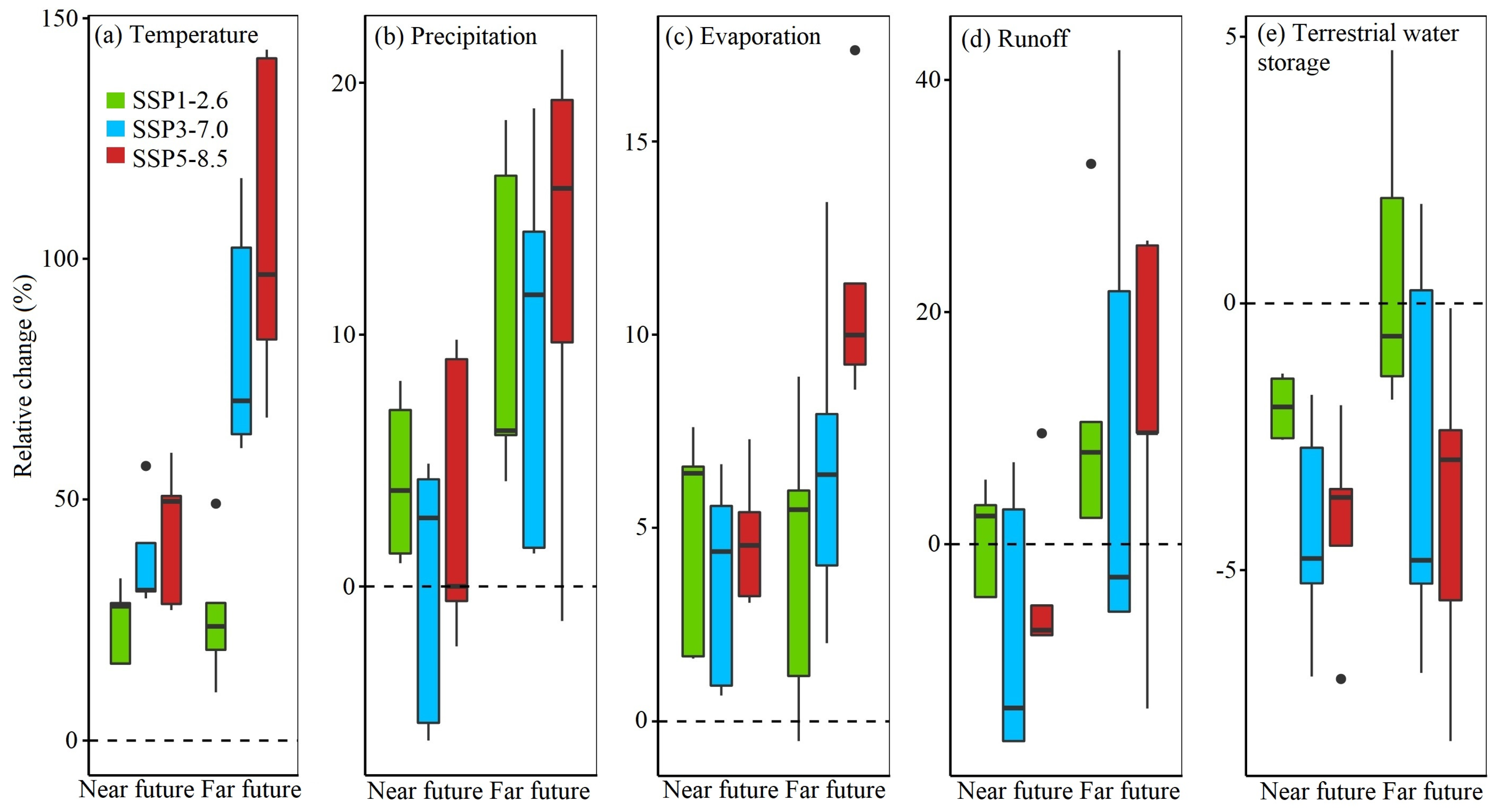
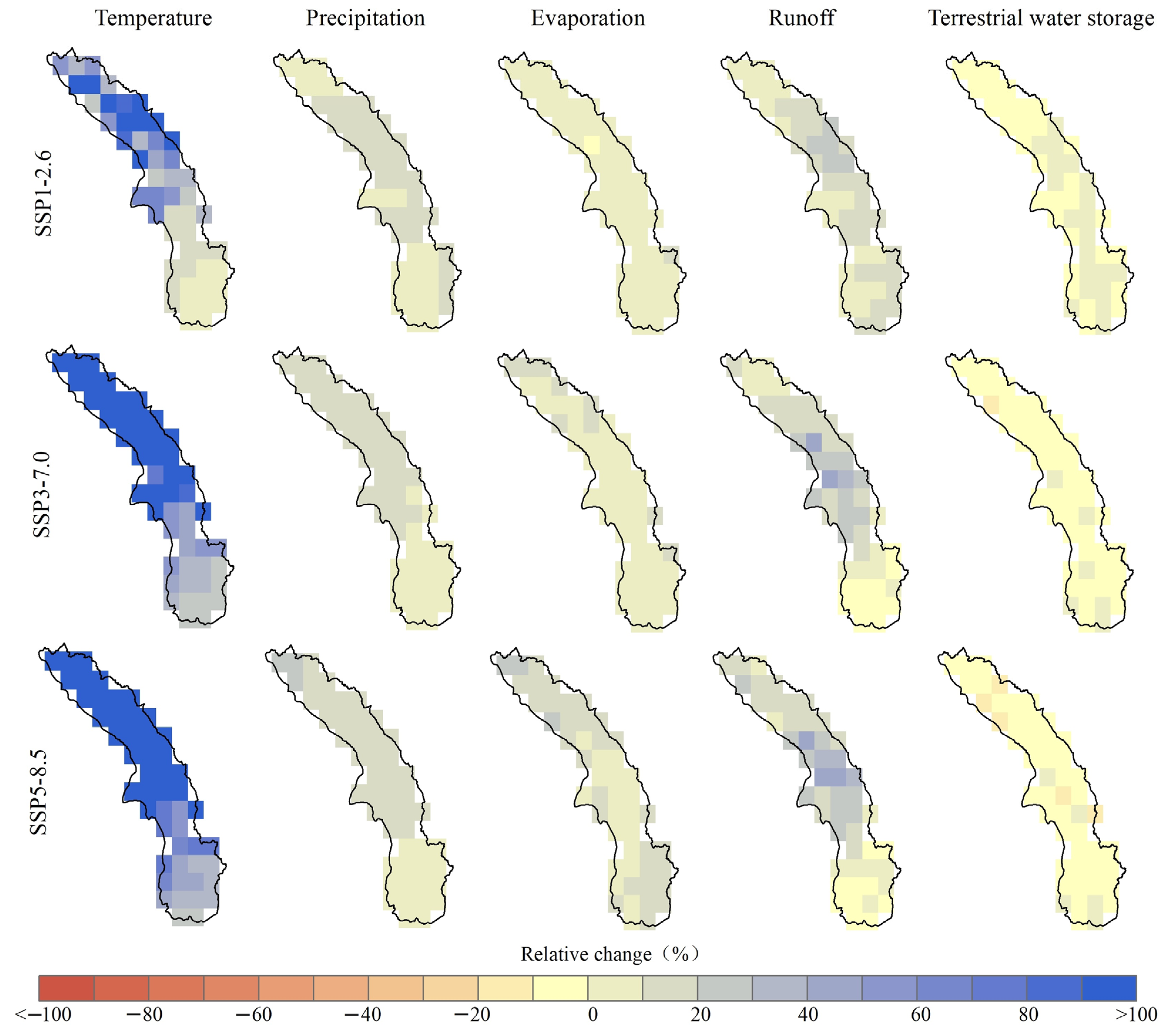
| Reservoir/Hydropower Dam | Lianghekou | Yangfanggou | Jingpin-I | Jingpin-II | Guandi | Ertan | Tongzhilin |
|---|---|---|---|---|---|---|---|
| Normal water level/m | 2865 | 2094 | 1880 | 1646 | 1330 | 1200 | 1015 |
| Dead water level/m | 2785 | 2088 | 1800 | 1640 | 1321 | 1155 | 1012 |
| Total storage/km3 | 10.767 | 0.513 | 7.990 | 0.019 | 0.760 | 5.800 | 0.091 |
| Active storage/km3 | 6.56 | 0.0538 | 4.911 | 0.004 | 0.123 | 3.370 | 0.015 |
| Installed capacity/MW | 3000 | 1500 | 3600 | 4800 | 2400 | 3300 | 600 |
| Annual power/109 kW·h | 11.0 | 5.97 | 16.62 | 24.99 | 11.87 | 17.00 | 2.975 |
| Regulation capacity | multi-year | daily | annual | daily | daily | seasonal | daily |
| First-impoundment year | 2000 | 2020 | 2012 | 2012 | 2011 | 1998 | 2015 |
| Completion year | 2023 | 2021 | 2015 | 2015 | 2013 | 2000 | 2016 |
| Group | IHA Indicators | 1959~1997 | 1998~2011 | 2012~2020 | ||||
|---|---|---|---|---|---|---|---|---|
| Average | 25% | 75% | Average | D0 (%) | Average | D0 (%) | ||
| Group 1 (m3/s) | January mean flow | 565 | 518 | 611 | 870 | 100% | 1173 | 100% |
| February mean flow | 504 | 464 | 533 | 779 | 100% | 1104 | 100% | |
| March mean flow | 491 | 449 | 520 | 769 | 85.7% | 1216 | 100% | |
| April mean flow | 579 | 540 | 639 | 713 | 57.1% | 997 | 100% | |
| May mean flow | 988 | 829 | 1091 | 902 | 28.6% | 982 | 33.3% | |
| June mean flow | 2171 | 1804 | 2854 | 2103 | 42.9% | 1541 | 55.6% | |
| July mean flow | 4084 | 3185 | 4777 | 4084 | 14.3% | 3186 | 55.6% | |
| August mean flow | 3621 | 3084 | 4566 | 4278 | 14.3% | 3106 | 11.1% | |
| September mean flow | 3971 | 3005 | 5059 | 4145 | 14.3% | 4135 | 55.6% | |
| October mean flow | 2519 | 2088 | 3099 | 2258 | 28.6% | 2718 | 33.3% | |
| November mean flow | 1256 | 1120 | 1437 | 1305 | 0.0% | 1344 | 11.1% | |
| December mean flow | 777 | 692 | 885 | 868 | 14.3% | 831 | 55.6% | |
| Group-2 (m3/s) | 1-day minimal flow | 471 | 439 | 496 | 482 | 16.7% | 550 | 55.6% |
| 3-day minimal flow | 1414 | 1315 | 1491 | 1523 | 33.3% | 1721 | 55.6% | |
| 7-day minimal flow | 3261 | 3055 | 3481 | 3304 | 57.1% | 3955 | 33.3% | |
| 30-day minimal flow | 14,508 | 13,354 | 15,207 | 18,132 | 100.0% | 21,201 | 77.8% | |
| 90-day minimal flow | 45,598 | 42,404 | 48,393 | 63,543 | 100.0% | 90,903 | 100.0% | |
| 1-day maximal flow | 8038 | 6931 | 9165 | 7981 | 50.0% | 7270 | 33.3% | |
| 3-day maximal flow | 22,358 | 19,376 | 25,412 | 21,847 | 33.3% | 20,278 | 33.3% | |
| 7-day maximal flow | 47,091 | 40,191 | 52,203 | 46,902 | 33.3% | 43,033 | 33.3% | |
| 30-day maximal flow | 158,028 | 136,716 | 179,272 | 157,583 | 0.0% | 141,406 | 11.1% | |
| 90-day maximal flow | 376,844 | 308,059 | 433,992 | 358,110 | 16.7% | 330,396 | 11.1% | |
| No. of base flow days | 1.77 | 1.60 | 2.05 | 1.78 | 0% | 2.15 | 33.3% | |
| No. of zero flow days | 0 | 0 | 0 | 0 | 0% | 0 | 0% | |
| Group-3 Julian date (d) | Annual minimum | 67 | 58 | 78 | 97 | 100% | 63 | 100% |
| Annual maximum | 223 | 193 | 246 | 229 | 28.6% | 239 | 11.1% | |
| Group-4 (d) | No. of high pulses | 4.0 | 3.5 | 5.0 | 6.8 | 14.3% | 8.6 | 77.8% |
| High pulse duration | 22.75 | 18.00 | 26.38 | 14.89 | 14.3% | 13.35 | 77.8% | |
| No. of low pulses | 3.0 | 2.0 | 4.0 | 16.88 | 85.7% | 13.8 | 100% | |
| Low pulse duration | 30.00 | 22.75 | 45.50 | 6.38 | 85.7% | 7.63 | 100% | |
| Group-5 | Rise rate | 6.60 | 6.06 | 7.34 | 12.63 | 100% | 12.27 | 77.8% |
| Fall rate | −3.37 | −3.52 | −3.14 | −9.28 | 100% | −8.97 | 100% | |
| Number of reversals | 66 | 59 | 73 | 167 | 100% | 195 | 100% | |
| Overall alteration | 60.4 | 68.4 | ||||||
Disclaimer/Publisher’s Note: The statements, opinions and data contained in all publications are solely those of the individual author(s) and contributor(s) and not of MDPI and/or the editor(s). MDPI and/or the editor(s) disclaim responsibility for any injury to people or property resulting from any ideas, methods, instructions or products referred to in the content. |
© 2023 by the authors. Licensee MDPI, Basel, Switzerland. This article is an open access article distributed under the terms and conditions of the Creative Commons Attribution (CC BY) license (https://creativecommons.org/licenses/by/4.0/).
Share and Cite
He, Y.; Xiong, J.; Guo, S.; Zhong, S.; Yu, C.; Ma, S. Using Multi-Source Data to Assess the Hydrologic Alteration and Extremes under a Changing Environment in the Yalong River Basin. Water 2023, 15, 1357. https://doi.org/10.3390/w15071357
He Y, Xiong J, Guo S, Zhong S, Yu C, Ma S. Using Multi-Source Data to Assess the Hydrologic Alteration and Extremes under a Changing Environment in the Yalong River Basin. Water. 2023; 15(7):1357. https://doi.org/10.3390/w15071357
Chicago/Turabian StyleHe, Yanfeng, Jinghua Xiong, Shenglian Guo, Sirui Zhong, Chuntao Yu, and Shungang Ma. 2023. "Using Multi-Source Data to Assess the Hydrologic Alteration and Extremes under a Changing Environment in the Yalong River Basin" Water 15, no. 7: 1357. https://doi.org/10.3390/w15071357
APA StyleHe, Y., Xiong, J., Guo, S., Zhong, S., Yu, C., & Ma, S. (2023). Using Multi-Source Data to Assess the Hydrologic Alteration and Extremes under a Changing Environment in the Yalong River Basin. Water, 15(7), 1357. https://doi.org/10.3390/w15071357







